The Cloud Effect on Data Center Networking

By Berge Ayvazian
Berge Ayvazian joined UBM Tech as a senior consultant on the Heavy Reading team in 2011, following more than 20 years as a senior telecom industry analyst and strategy consultant with Yankee Group, where he served as CEO, CRO, and CSO. Ayvazian has been a regular contributor of analyst notes, white papers, and webcasts for Light Reading, and he now contributes to the custom research, consulting, publishing, and conference programs through UBM Tech’s Create division. He conducts custom research and consulting projects on the convergence of broadband and mobility, cloud and enterprise applications and networks.
Enterprise IT departments are seeking high-performance connections to data centers for mission-critical, cloud-based applications.
Enterprises have turned to cloud-based applications hosted in remote data centers to increase productivity, manage spending, and drive competitive advantage. And enterprises aren’t alone – businesses of all sizes are now running a wide range of applications in the cloud, including accounting, HR, and salesforce and customer relationship management (CRM).
With business applications moving to the cloud, most companies now provide employee access to their enterprise software applications via the Internet and through mobile devices. But concerns about security, reliability, performance, and control are driving enterprise IT departments to evaluate the network infrastructure and services that connect their company locations to data centers.
Whether enterprises connect to their cloud-based resources in data centers via the Internet, with private connections, or by combining these two approaches, one thing is clear: Organizations are searching for the best method to maintain high reliability and up-time while achieving low latency and high response time. These factors provide the key to leveraging the full potential of customized and mission-critical applications hosted in dedicated, private cloud data centers.
This is one of the key findings in “The State of Data Center Networking,” a comprehensive study by UBM Tech of more than 300 IT decision makers and senior executives from organizations across a wide range of industries. The research reveals companies’ requirements for connecting with mission-critical data centers today, how they are connecting, how well those solutions are working, and their plans to meet future requirements.
Cloud Soars
For customized and mission-critical applications, private cloud data center solutions deliver usage-based, dedicated cloud computing infrastructure and storage solutions, allowing enterprise IT to access virtualized servers on a pay-as-you-go basis for capacity to scale on demand as well as backup and disaster recovery. There’s no doubt that cloud-based applications make business operations more efficient, provide flexibility and ease of use, reduce cost, and increase scalability. That’s why 62% of respondents to the UBM Tech survey currently use cloud-based applications – a number that rises to 68% of those at companies with more than 100 employees. (See Figure 1.)
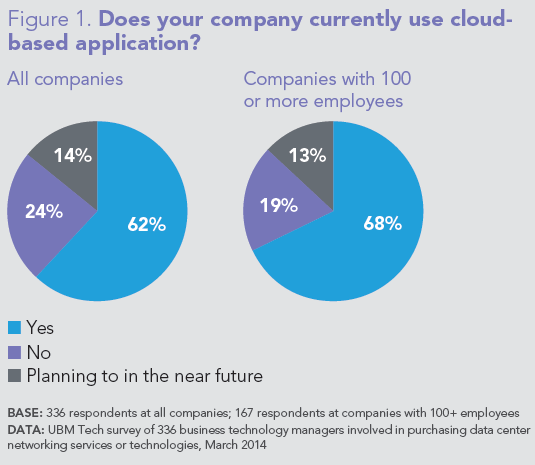
The popularity of cloud options is tied to the business environment enterprises face. On the one hand, companies are driven to increase revenues by acquiring new customers, improving customer experience, building customer loyalty, increasing sales from existing customers, and introducing new products and services. At the same time, they’re compelled to reduce expenses to maintain or grow their profit margins. (See Figure 2.)
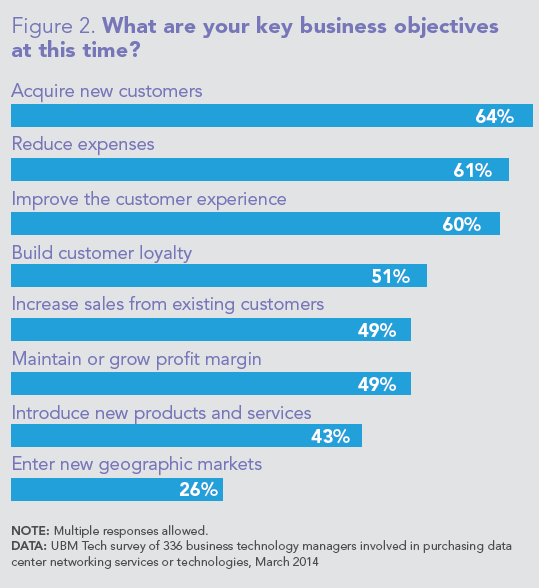
Both larger and smaller companies are using a variety of enterprise applications in the public cloud, including storage, messaging, CRM, collaboration, sales, and account management. Less likely to be hosted in the public cloud were business-critical applications such as accounting, billing, and enterprise resource management (ERP). (See Figure 3.)
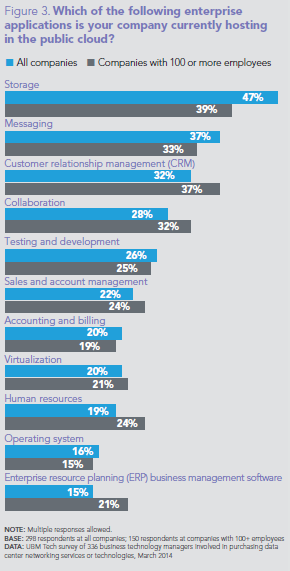
Questions Remain
But respondents to the UBM Tech survey identified significant challenges and stumbling blocks that have prevented them from using off-site, third-party, hosted applications/resources. The 24% of respondents not using cloud-based applications reported that security and a loss of control are major concerns when it comes to cloud. A significant number (31%) of enterprises with more than 100 employees also cite concerns about finding trustworthy service providers. (See Figure 4.)
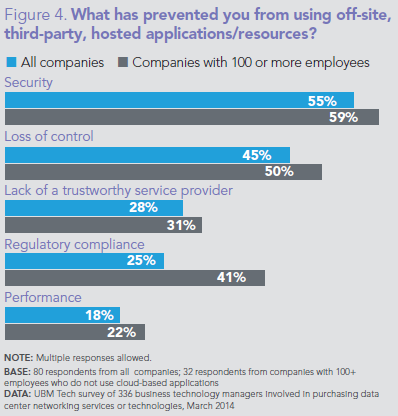
Approximately half of respondents reported the use of the Internet to access cloud-based applications and resources, while only 31% reported the use of private connections. Another 11% of respondents reported the use of a combination of Internet and private connections. (See Figure 5.)
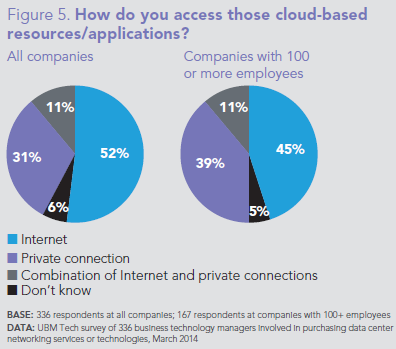
As Internet security and other concerns rise, organizations are likely to look for connectivity options that better align to their key selection criteria. And security isn’t the only consideration: A recent study by the Equinix Solution Validation Center showed a 147% increase in throughput when enterprises directly connect to the cloud, eliminating the bottlenecks associated with traditional public Internet connections to cloud computing resources. With applications being virtualized among many data center platforms, 54% of all survey respondents reported that they do not know which data centers host their cloud-based services. This dropped slightly to 49% among respondents from larger enterprises. (See Figure 6.)
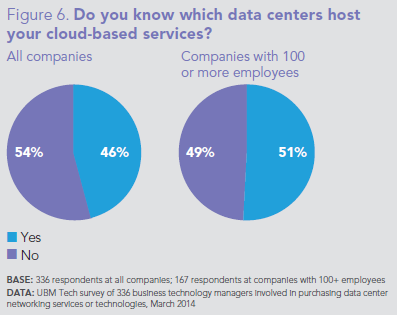
Private Cloud at Work
Only 43% of all respondents reported that their companies host customized and mission-critical applications in a dedicated, private cloud data center under the control of the IT department within the corporate firewall. This percentage increased slightly to 51% among respondents from larger and midsized enterprises with more than 100 employees. (See Figure 7.)
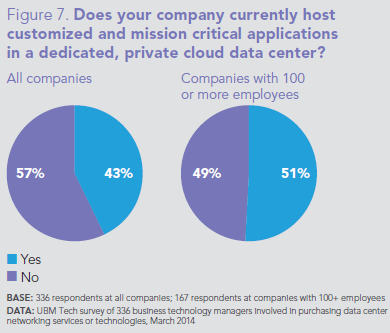
Most survey respondents report that their companies use Internet (60%), private connections (59%), or a combination of both to connect with customized and mission-critical applications hosted in a dedicated, private cloud data center. The use of private connections increases slightly to 69% among respondents from larger and midsized enterprises with more than 100 employees. Although over-the-top (OTT) Internet connections offer the least expensive means for connecting companies to cloud computing data centers, the limitations are significant in terms of the uptime, reliability, latency, scalability, and security. (See Figure 8.)

Among those using private data center connections, the majority of respondents (59%) report that their companies still use legacy private lines, with 37% using Layer 3 VPN and only 34% using Carrier Ethernet services for private data center connections. The use of fiber-based Carrier Ethernet services is quite consistent among respondents from larger and midsized enterprises with more than 100 employees, and for connecting remote office locations and branches to cloud data centers. (See Figure 9.)

Gaps and Contradictions
The UBM Tech survey results point out several gaps and contradictions in the data center networking strategies of midsized enterprises.
One example is the perception of the adequacy of their current data center connectivity. A total of 74% of respondents to the UBM Tech survey are somewhat, quite, or very satisfied with their current mode of data center connectivity. Only 5% of respondents expressed any dissatisfaction with their current mode of data center connectivity. (See Figure 10.)
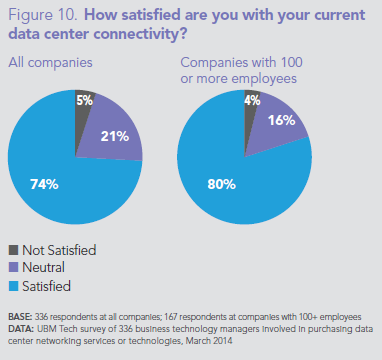
Yet survey respondents identified several major challenges for connecting to mission-critical, third-party, remote data centers, including maintaining high reliability and up-time, achieving low latency and high response time, and increasing capacity as usage grows.
Regarding the criteria for selecting a solution for private data center connections, respondents identified reliability, security, high speed, low cost, low latency, capacity, and scalability as very important criteria in selecting a solution for data center networking. (See Figure 11.)
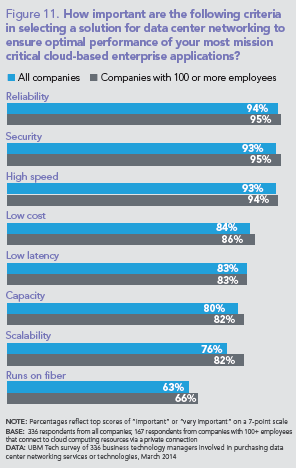
Yet the majority of respondents report that their companies still use dedicated point-to-point circuits and legacy private lines from traditional telcos, even though they are not scalable or flexible enough for connecting to remote data centers hosting mission-critical, cloud-based enterprise applications.
Selecting a Data Center Networking Provider
Despite their apparent satisfaction with the connectivity status quo, enterprise IT decision makers must soon seek solutions for data center networking connectivity that will help their companies unlock the full potential of cloud computing applications. This requires a careful examination of the trade-offs between available data center connectivity options to support robust, reliable, scalable, and secure networking designed to keep cloud users connected and business applications running smoothly.
Respondents recognize several companies as leaders in connecting enterprises with mission-critical data centers. Among these are the leading telcos and Internet service providers, as well as cable broadband providers such as Comcast Business. (See Figure 12.)
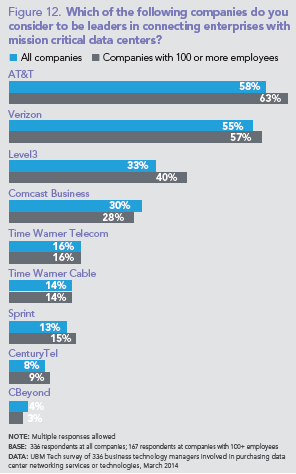
Service providers have a significant opportunity to gain market share by linking the benefits of their connectivity solutions to the most important criteria identified by survey respondents in selecting a data center networking provider.
As midsized enterprises become aware of the associated cost efficiency and improved network performance, look for more to select Ethernet connectivity. Compared to other options, Ethernet connectivity provides low latency and flexible, reliable, secure, and cost-effective alternatives to private lines or Layer 3 VPN for Internet access and virtual point-to-point and multipoint connections to multiple data centers. The scalable bandwidth it supplies can be deployed quickly and added to keep pace with the growth of the business.
Download this report as a PDF.
Interested in learning about Ethernet solutions from Comcast Business? Visit http://business.comcast.com/ethernet
Enterprise IT departments are seeking high-performance connections to data centers for mission-critical, cloud-based applications.
Locked Content
Click on the button below to get access
Unlock NowOr sign in to access all content on Comcast Business Community
Tags
Learn how Comcast Business can help
keep you ready for what's next.










